不同的口味 Different Flavor_英语作文_1
- 格式:docx
- 大小:15.71 KB
- 文档页数:1
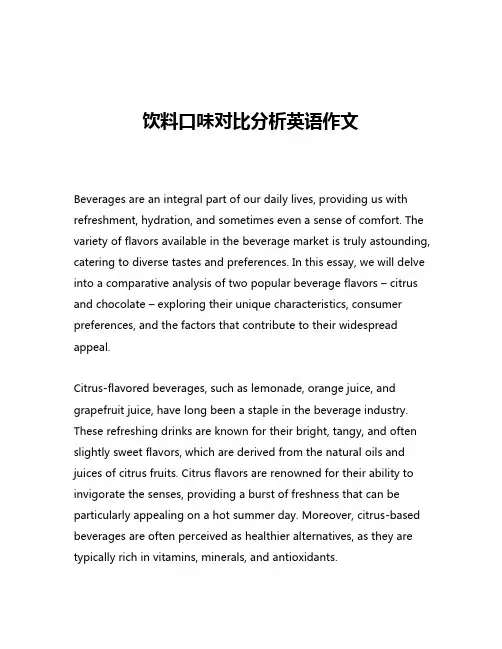
饮料口味对比分析英语作文Beverages are an integral part of our daily lives, providing us with refreshment, hydration, and sometimes even a sense of comfort. The variety of flavors available in the beverage market is truly astounding, catering to diverse tastes and preferences. In this essay, we will delve into a comparative analysis of two popular beverage flavors – citrus and chocolate – exploring their unique characteristics, consumer preferences, and the factors that contribute to their widespread appeal.Citrus-flavored beverages, such as lemonade, orange juice, and grapefruit juice, have long been a staple in the beverage industry. These refreshing drinks are known for their bright, tangy, and often slightly sweet flavors, which are derived from the natural oils and juices of citrus fruits. Citrus flavors are renowned for their ability to invigorate the senses, providing a burst of freshness that can be particularly appealing on a hot summer day. Moreover, citrus-based beverages are often perceived as healthier alternatives, as they are typically rich in vitamins, minerals, and antioxidants.In contrast, chocolate-flavored beverages, including hot chocolate, chocolate milk, and mocha-based drinks, offer a more indulgent and comforting experience. The rich, creamy, and often decadent flavors of chocolate-infused beverages appeal to those seeking a more indulgent and satisfying drinking experience. Chocolate's inherent sweetness, combined with its distinctive aroma and mouthfeel, creates a sense of comfort and nostalgia for many consumers.When it comes to consumer preferences, both citrus and chocolate-flavored beverages have their ardent supporters. Citrus-based drinks are often favored by those seeking a refreshing and rejuvenating beverage, particularly during the warmer months. The bright and tangy flavors of citrus can help to quench thirst and provide a sense of revitalization. Chocolate-flavored beverages, on the other hand, tend to be more popular among individuals who crave a more indulgent and comforting drinking experience. The rich and creamy textures of chocolate-based drinks can provide a sense of indulgence and comfort, making them a popular choice during the colder seasons or as a treat.One of the key factors that contribute to the widespread appeal of both citrus and chocolate-flavored beverages is their versatility. Citrus flavors can be incorporated into a wide range of beverages, from traditional lemonade to more innovative cocktails and smoothies. Similarly, chocolate-flavored drinks can be enjoyed invarious forms, from hot cocoa to iced coffee-based concoctions. This versatility allows consumers to explore and experiment with different flavor combinations, catering to their individual preferences and mood.Another factor that has driven the popularity of these beverage flavors is the growing emphasis on health and wellness. Citrus-based drinks, with their high vitamin C content and antioxidant properties, are often perceived as a healthier choice, particularly among health-conscious consumers. Chocolate-flavored beverages, on the other hand, have also seen a surge in popularity due to the growing recognition of the potential health benefits of dark chocolate, which is rich in flavonoids and other beneficial compounds.Despite their distinct flavor profiles, citrus and chocolate-based beverages share some common challenges in the beverage market. Both must contend with the ever-evolving preferences of consumers, who are constantly seeking new and innovative flavor experiences. Beverage manufacturers must continuously adapt and innovate to stay ahead of the curve, introducing new flavor combinations and product formulations to cater to changing tastes and trends.Moreover, both citrus and chocolate-flavored beverages face competition from a wide range of alternative beverage options, such as energy drinks, sparkling waters, and plant-based milk alternatives.These competing products can offer unique flavor profiles and perceived health benefits, which may sway some consumers away from traditional citrus and chocolate-based drinks.In conclusion, the comparative analysis of citrus and chocolate-flavored beverages reveals the distinct yet complementary nature of these two popular beverage categories. Citrus-based drinks are known for their refreshing and invigorating qualities, while chocolate-flavored beverages offer a more indulgent and comforting experience. Both flavors have garnered loyal followings among consumers, driven by factors such as versatility, health perceptions, and the ongoing need for innovation in the beverage industry. As the market continues to evolve, it will be interesting to observe how these two flavor profiles adapt and evolve to meet the changing demands of consumers.。

小学生英语作文中秋节的传统饮食与美食(中英文翻译)中秋节是中国传统的重要节日之一,也是一个家庭团聚、品尝美食的好时机。
小学生英语作文中秋节的传统饮食与美食中秋节,又称团圆节,是中国传统的重要节日之一。
家家户户都会举行团圆饭,享受团聚的喜悦。
而在中秋节,传统的饮食和美食更是少不了的。
接下来,让我们一起来探索一下中秋节的传统饮食和美食吧!1. 月饼(Mooncakes)月饼是中秋节最具代表性的传统美食之一。
月饼的外观呈圆形,象征着团圆和和谐。
月饼的馅料丰富多样,有莲蓉、豆沙、五仁等。
此外,一些地方还有特色的月饼,如广东的蛋黄莲蓉月饼和苏式鲜肉月饼。
不同的月饼口味,总有一款适合你的味蕾。
2. 柚子(Pomelo)柚子是中秋节必备的水果之一。
它是一种大型的柑橘类水果,外皮厚而坚实,果肉鲜美。
柚子也被看作是一种吉祥的象征,寓意着团圆和好运。
人们喜欢一家人围坐在一起,剥开柚子,分享它的美味。
3. 莲藕(Lotus Root)莲藕是一种常见的蔬菜,在中秋节也十分受欢迎。
莲藕富含多种营养物质,口感鲜嫩爽脆。
在中秋节时,有的家庭会煮莲藕汤或者炒莲藕片,让人们品尝到莲藕独特的香味和口感。
4. 粽子(Zongzi)粽子是中秋节传统的特色食品之一。
它是用粳米加入各种馅料,裹在竹叶中蒸煮而成。
不同地区的粽子有着不同的口味和做法。
一些地方的粽子馅料有肉类、豆沙、蜜枣等,口感丰富多样。
粽子的形状多为三角形或者长方形,制作精美,也很好吃。
5. 葡萄(Grape)葡萄是中秋节时的另一种水果选择。
中秋节正值葡萄丰收的季节,各种品种的葡萄都会上市。
南方的葡萄种类多样,味道甜美,而北方的葡萄则比较酸爽。
无论是红葡萄还是绿葡萄,都是中秋节餐桌上的常客。
6. 鸭子(Duck)在一些地方,人们习惯在中秋节吃鸭子。
鸭肉鲜嫩多汁,肉质醇香,成为了中秋节美食中的佳肴之一。
有的家庭会准备一只烤鸭作为中秋节的招待食品,展示出中国独特的烹饪技巧和口味。
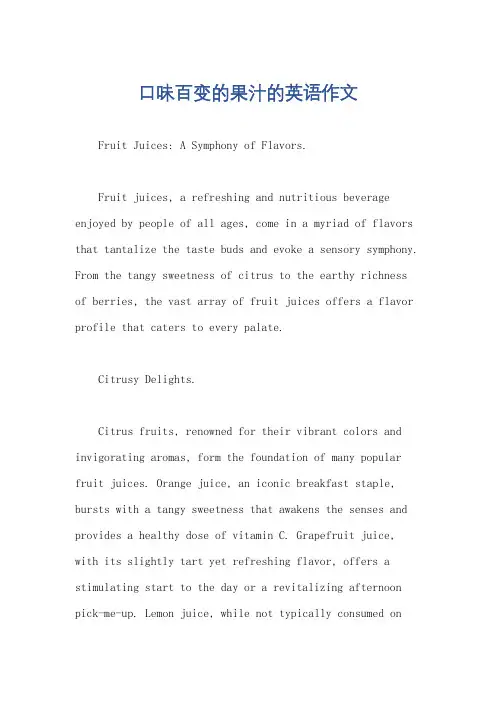
口味百变的果汁的英语作文Fruit Juices: A Symphony of Flavors.Fruit juices, a refreshing and nutritious beverage enjoyed by people of all ages, come in a myriad of flavors that tantalize the taste buds and evoke a sensory symphony. From the tangy sweetness of citrus to the earthy richness of berries, the vast array of fruit juices offers a flavor profile that caters to every palate.Citrusy Delights.Citrus fruits, renowned for their vibrant colors and invigorating aromas, form the foundation of many popular fruit juices. Orange juice, an iconic breakfast staple, bursts with a tangy sweetness that awakens the senses and provides a healthy dose of vitamin C. Grapefruit juice, with its slightly tart yet refreshing flavor, offers a stimulating start to the day or a revitalizing afternoon pick-me-up. Lemon juice, while not typically consumed onits own, adds a zesty kick to cocktails, marinades, and desserts, imparting a bright and tangy note.Tropical Temptations.Venture into the realm of tropical fruits, and a kaleidoscope of exotic flavors awaits. Mango juice, withits velvety texture and luscious sweetness, transports you to the sun-drenched beaches of distant lands. Pineapple juice, bursting with a vibrant golden hue, offers a vibrant balance of sweetness and acidity, making it a perfect accompaniment to both sweet and savory dishes. Guava juice, with its unique aromatic and subtly floral notes, provides a taste of the tropics that is both refreshing and intriguing.Berry Bonanza.Berries, nature's sweet and tart wonders, lend their vibrant colors and complex flavors to a plethora of fruit juices. Strawberry juice, with its vibrant red hue and tantalizing aroma, embodies the essence of summer, offeringa sweet and slightly tangy burst of flavor. Blueberry juice, boasting a deep purple hue and a slightly tart yet fruity taste, provides a rich source of antioxidants and a refreshing twist on classic berry flavors. Raspberry juice, with its delicate sweetness and hint of floral notes,offers a sophisticated sipping experience that is both indulgent and revitalizing.Earthy Essences.Beyond the bright and vibrant flavors of citrus and berries, fruit juices can also showcase the earthy andsubtle notes of certain fruits. Pomegranate juice, with its deep crimson hue and slightly tart flavor, is a rich source of antioxidants and provides a complex and intriguingsipping experience. Cranberry juice, known for its deepruby color and tart yet refreshing taste, is often enjoyed as a healthy and flavorful beverage. Acai juice, derived from the Amazonian rainforest, offers a unique earthyflavor with a hint of sweetness, making it a popular choice among health-conscious consumers.Blends and Combinations.The world of fruit juices extends beyond single-fruit varieties, with countless opportunities for blending and combining flavors to create unique and tantalizing beverages. Orange-mango juice, for instance, marries the vibrant sweetness of orange with the tropical lusciousness of mango, resulting in a harmonious blend that delights the taste buds. Strawberry-banana juice, a classic combination, offers a sweet and creamy texture with a hint of tangy strawberry flavor. Pineapple-guava juice, a tropical delight, combines the vibrant acidity of pineapple with the subtle sweetness of guava, creating a refreshing and exotic concoction.Health Benefits Galore.Fruit juices, in addition to their delectable flavors, offer a myriad of health benefits. Citrus juices, rich in vitamin C, support immune function and protect against free radical damage. Berry juices, packed with antioxidants, may reduce inflammation and promote heart health. Pomegranatejuice has been shown to lower blood pressure and improve cholesterol levels. Acai juice is a powerhouse of antioxidants, providing anti-aging and anti-inflammatory properties.Conclusion.Fruit juices, a tapestry of flavors that span the spectrum from tangy to sweet, earthy to vibrant, offer a refreshing and nutritious way to quench thirst and indulge the senses. Whether enjoyed as a morning pick-me-up, an afternoon refreshment, or a sophisticated evening beverage, fruit juices provide a boundless culinary adventure that satisfies every palate.。
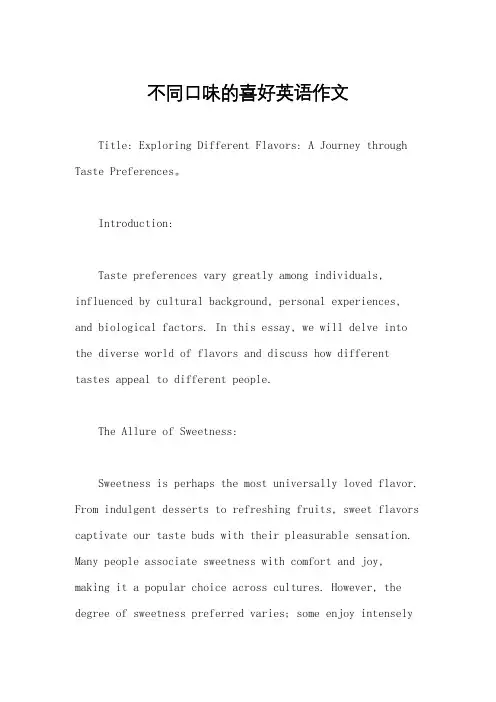
不同口味的喜好英语作文Title: Exploring Different Flavors: A Journey through Taste Preferences。
Introduction:Taste preferences vary greatly among individuals, influenced by cultural background, personal experiences, and biological factors. In this essay, we will delve into the diverse world of flavors and discuss how different tastes appeal to different people.The Allure of Sweetness:Sweetness is perhaps the most universally loved flavor. From indulgent desserts to refreshing fruits, sweet flavors captivate our taste buds with their pleasurable sensation. Many people associate sweetness with comfort and joy, making it a popular choice across cultures. However, the degree of sweetness preferred varies; some enjoy intenselysweet treats, while others prefer more subtle sweetness.The Temptation of Saltiness:Saltiness adds depth and savory richness to dishes, enhancing their overall flavor profile. Some individuals are drawn to salty snacks like potato chips or pretzels, craving the satisfying crunch and savory taste. However, excessive salt consumption can lead to health issues such as hypertension, so it's essential to enjoy salty foods in moderation.The Allure of Sourness:Sourness adds a tangy, zesty dimension to food and beverages. Citrus fruits like lemons and limes are prized for their refreshing sour flavor, while fermented foods like kimchi and sauerkraut offer a distinctive sour taste with underlying complexity. Sour flavors can awaken the palate and complement other tastes, making them a popular choice in cuisines around the world.The Richness of Bitterness:Bitterness is a complex flavor often associated with foods like dark chocolate, coffee, and leafy greens. While some may find bitter flavors off-putting at first, many develop an appreciation for their depth and complexity over time. Bitterness adds balance to dishes, cutting through sweetness or richness to create a harmonious flavor profile.The Umami Experience:Umami, often described as savory or meaty, is the fifth basic taste alongside sweetness, saltiness, sourness, and bitterness. It can be found in foods like mushrooms, tomatoes, and aged cheeses, imparting a deep, satisfying flavor that lingers on the palate. Umami enhances theoverall taste experience, adding depth and richness to dishes.Cultural Influences on Taste Preferences:Taste preferences are deeply influenced by culturalfactors. For example, in Asian cultures, umami-rich ingredients like soy sauce and fish sauce are integral to many dishes, while in Western cuisines, sweetness and saltiness often take center stage. Additionally, regional specialties and traditional cooking methods shape people's flavor preferences, resulting in a diverse tapestry of culinary delights around the world.Conclusion:In conclusion, taste preferences are as varied and nuanced as the individuals who possess them. From the comforting sweetness of desserts to the boldness of umami-rich dishes, each flavor offers a unique sensory experience. By exploring the diverse world of flavors, we gain a deeper understanding of ourselves and the rich tapestry ofculinary traditions that enrich our lives.。
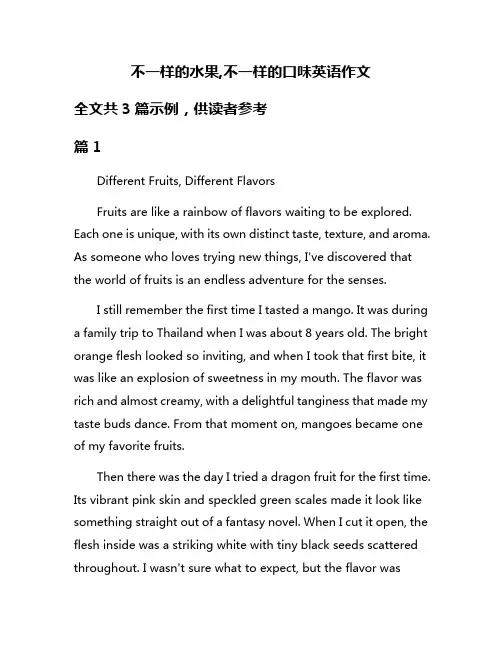
不一样的水果,不一样的口味英语作文全文共3篇示例,供读者参考篇1Different Fruits, Different FlavorsFruits are like a rainbow of flavors waiting to be explored. Each one is unique, with its own distinct taste, texture, and aroma. As someone who loves trying new things, I've discovered that the world of fruits is an endless adventure for the senses.I still remember the first time I tasted a mango. It was duringa family trip to Thailand when I was about 8 years old. The bright orange flesh looked so inviting, and when I took that first bite, it was like an explosion of sweetness in my mouth. The flavor was rich and almost creamy, with a delightful tanginess that made my taste buds dance. From that moment on, mangoes became one of my favorite fruits.Then there was the day I tried a dragon fruit for the first time. Its vibrant pink skin and speckled green scales made it look like something straight out of a fantasy novel. When I cut it open, the flesh inside was a striking white with tiny black seeds scattered throughout. I wasn't sure what to expect, but the flavor wasunlike anything I'd ever tasted before – subtly sweet with a slightly crunchy texture. It was like nature's own sorbet, refreshing and unique.Of course, no discussion of unique fruits would be complete without mentioning the durian. This spiky, football-sized fruit is notorious for its intense aroma, which some people love and others can't stand. To me, it smells like a mix of dirty socks and sweet custard – not exactly appealing, but strangely intriguing. When I finally mustered the courage to try it, the flavor was unexpectedly delicious, rich and creamy with a hint of almonds. It's no wonder the durian is revered as the "king of fruits" in Southeast Asia.But it's not just exotic fruits that offer a world of flavors to explore. Even the most common fruits can surprise you if you're open to trying new varieties. Take apples, for example. We're all familiar with the classic Red Delicious, but have you ever tried a Pink Pearl or a Honeycrisp? The Pink Pearl has a beautiful rosy hue and a crisp, juicy flesh with a perfect balance of sweetness and tartness. The Honeycrisp, on the other hand, lives up to its name with an incredibly crisp texture and a honey-like sweetness that lingers on your tongue.Then there are the different varieties of citrus fruits, each with its own unique spin on that familiar tangy flavor. Satsumas are like little bursts of sunshine, with their easy-to-peel skin and sweet, nearly seedless flesh. Blood oranges, with their deep crimson color and rich, almost berry-like taste, are a winter treat. And let's not forget the humble grapefruit, which can range from mouth-puckeringly tart to delightfully sweet, depending on the variety.But perhaps the most fascinating thing about fruits is how their flavors can change depending on where they're grown and how they're cultivated. A Cavendish banana grown in Ecuador will taste subtly different from one grown in the Philippines, thanks to variations in soil, climate, and growing methods. The same goes for pineapples, with those grown in Hawaii having a slightly more acidic tang than their Costa Rican counterparts.It's this incredible diversity of flavors that keeps me endlessly curious and eager to try new fruits whenever I can. Each one is a little adventure, a chance to explore a world of tastes and textures that I may never have experienced before.Of course, not everyone has the same taste preferences when it comes to fruits. What I find deliciously tangy, my best friend might find too sour. What she thinks is perfectly sweet, Imight find a bit too cloying. But that's part of the beauty of it –there's a fruit out there for every palate, waiting to be discovered and savored.So the next time you're at the grocery store or farmer's market, don't be afraid to venture beyond the familiar. Pick up that weird-looking fruit you've never tried before and give it a chance. Who knows? It might just become your new favorite flavor. Because in the world of fruits, there's always something new and delicious waiting to be explored.篇2A Kaleidoscope of Flavors: Exploring the Wonderful World of FruitsAs a student with an insatiable curiosity and a deep appreciation for nature's bounty, I have always been fascinated by the incredible diversity of fruits that grace our planet. From the vibrant and juicy citrus fruits to the luscious and exotic tropical delights, each fruit offers a unique and tantalizing flavor experience that delights the senses and ignites the imagination.Growing up, I was fortunate enough to have a backyard filled with fruit trees, which allowed me to indulge in the simple pleasures of plucking a ripe apple straight from the branch orsavoring the sun-kissed sweetness of a freshly picked peach. These early encounters with nature's edible treasures sparked an enduring love affair with fruits that has only deepened over the years.One of the aspects that I find most captivating about fruits is their incredible range of flavors. Just as every individual has a distinct personality, each fruit possesses its own unique flavor profile, a delicate balance of sweetness, tartness, and complexity that dances on the taste buds like a masterful symphony.Consider the humble orange, a fruit that many of us take for granted. Yet, within its vibrant, sunset-hued skin lies a world of flavor possibilities. From the tangy and zesty Seville oranges that lend their distinctive tang to marmalades, to the sweet and juicy navel oranges that burst with refreshing citrus notes, each variety offers a distinct and delightful experience.And what about the beloved apple? This ubiquitous fruit, which has been a staple in human diets for centuries, comes in a dazzling array of varieties, each with its own unique flavor profile. The crisp and tart Granny Smith, the sweet and aromatic Honeycrisp, the classic and well-balanced Red Delicious – each one a testament to the incredible diversity that nature has bestowed upon us.But the wonders of the fruit world extend far beyond the familiar. As I have ventured further into the realm of exotic and tropical fruits, I have been utterly captivated by the kaleidoscope of flavors that await the intrepid taste explorer.Who could resist the allure of the mangosteen, with its vibrant purple hue and creamy, sweet-tart flesh that melts in the mouth like a heavenly nectar? Or the enigmatic durian, with its pungent aroma and custard-like texture that has been known to polarize even the most adventurous palates?And let us not forget the beloved mango, a true masterpiece of tropical flavor. From the velvety Alphonso to the fragrant Ataulfo, each variety offers a distinct and tantalizing experience, with notes of honey, citrus, and even a hint of pine that linger on the tongue long after the last bite.As I have delved deeper into the world of fruits, I have come to appreciate not only their flavors but also their rich cultural significance. Across the globe, fruits have played a pivotal role in shaping culinary traditions, folklore, and even religious symbolism.In ancient Greece, the pomegranate was revered as a symbol of fertility and abundance, its ruby-red arils representing the countless seeds within. In Buddhist traditions, the lychee, with itsdelicate white flesh and sweet, floral essence, is believed to bestow longevity and good fortune upon those who partake of its delights.And who could forget the iconic apple, a fruit that has been woven into the very fabric of human storytelling and mythology, from the biblical tale of Eve's temptation to the legends of Greek goddesses bestowing golden apples upon mortals?As a student of life, I am constantly in awe of the incredible diversity and richness that nature has to offer, and fruits are perhaps the most tangible and delectable manifestation of this bounty. Each bite, each flavor, each aroma is a journey unto itself, a celebration of the wonders that surround us and a reminder of the boundless creativity of the natural world.Whether savoring the familiar sweetness of a ripe strawberry or embarking on a flavor odyssey with an exotic cherimoya, the exploration of fruits is a lifelong pursuit that never ceases to delight and surprise. As I continue on my culinary and intellectual journey, I eagerly anticipate the countless new flavors and experiences that await, each one a precious jewel in the kaleidoscope of nature's edible treasures.篇3Different Fruits, Different FlavorsFruits are one of nature's most delightful gifts to us. They are not only packed with essential vitamins, minerals, and antioxidants that nourish our bodies, but they also offer a dazzling array of flavors that can tantalize our taste buds. From the tart tang of a lemon to the luscious sweetness of a perfectly ripe mango, each fruit has its own unique flavor profile that sets it apart from the rest.One of the things I find most fascinating about fruits is how their flavors can vary so dramatically depending on their ripeness, growing conditions, and even the specific variety. Take apples, for instance. A crisp, tart Granny Smith apple tastes worlds apart from a sweet, juicy Honeycrisp or a slightly tangy Gala. And let's not forget about the countless heirloom varieties that boast flavors unlike any commercially grown apple you'll find in the supermarket.Then there are fruits like pineapples, which can range from mouth-puckeringly tart to almost cloyingly sweet, depending on how ripe they are when picked. Or consider the humble banana –when underripe, it has an almost starchy, slightly bitter taste, but as it ripens, it develops a rich, creamy sweetness that is simply divine.But it's not just the flavors themselves that make fruits so fascinating; it's also the way they can be combined and transformed through cooking and baking. A tart Granny Smith apple, for instance, might be too mouth-puckering to enjoy on its own, but when baked into a pie with sugar, spices, and a buttery crust, it becomes a heavenly treat. Or consider the humble lemon – while its bright, acidic flavor might be too intense to enjoy on its own, it can be mellowed and balanced by combining it with sugar to make a tangy lemon curd or a refreshing lemonade.And then there are the endless possibilities for combining different fruits to create new and exciting flavor combinations. A classic example is the strawberry-banana smoothie, where the bright tartness of the strawberries is tempered by the rich creaminess of the bananas. Or consider a tropical fruit salad, where the sweet, floral notes of pineapple and mango are complemented by the tangy zing of kiwi and the rich creaminess of coconut.Of course, not everyone has the same taste preferences when it comes to fruits. Some people prefer the sweetness of fruits like mangoes and pineapples, while others gravitate towards the tartness of citrus fruits like lemons and limes. Andthen there are those who appreciate the complex, nuanced flavors of fruits like guava, passionfruit, and dragon fruit, which can be both sweet and tangy at the same time.Personally, I'm a fan of all kinds of fruits, but I have to admit that I have a particular soft spot for berries. There's just something about the bright, tangy flavors of raspberries, blackberries, and blueberries that I find utterly irresistible. And when you combine them with other fruits, like in a mixed berry pie or a smoothie bowl, the flavor combinations are simply out of this world.But beyond their flavors, fruits also offer a delightful sensory experience in terms of their textures and aromas. Think of the satisfying crunch of a crisp apple, or the velvety smoothness of a perfectly ripe avocado. Or consider the intoxicating aroma of a freshly sliced mango or pineapple, which can transport you to a tropical paradise with just a single whiff.Of course, not all fruits are created equal when it comes to their health benefits. Some, like citrus fruits and berries, are packed with vitamin C and other antioxidants that can help boost our immune systems and protect our bodies from disease. Others, like bananas and avocados, are rich in potassium andother essential nutrients that can help regulate our blood pressure and support healthy muscle function.But regardless of their specific nutritional profiles, all fruits offer a delicious and healthy way to satisfy our sweet cravings without resorting to processed sugars or artificial sweeteners. And with so many different varieties and flavors to choose from, there's truly something for everyone – whether you're a fan of tart, tangy flavors or prefer something a little sweeter and more mellow.In conclusion, fruits are a true culinary treasure trove, offering a dazzling array of flavors, textures, and aromas that can delight our senses and nourish our bodies. From the humble apple to the exotic dragon fruit, each fruit has its own unique flavor profile that sets it apart from the rest. And whether you prefer your fruits sweet, tart, or somewhere in between, there's no denying that they are one of nature's most delicious and satisfying gifts. So why not embrace the diversity of flavors that fruits have to offer, and embark on a delicious journey of discovery? Your taste buds will thank you.。
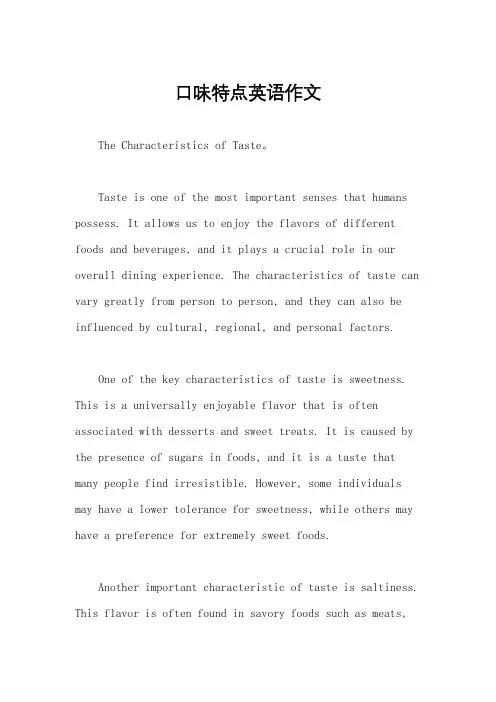
口味特点英语作文The Characteristics of Taste。
Taste is one of the most important senses that humans possess. It allows us to enjoy the flavors of different foods and beverages, and it plays a crucial role in our overall dining experience. The characteristics of taste can vary greatly from person to person, and they can also be influenced by cultural, regional, and personal factors.One of the key characteristics of taste is sweetness. This is a universally enjoyable flavor that is often associated with desserts and sweet treats. It is caused by the presence of sugars in foods, and it is a taste that many people find irresistible. However, some individuals may have a lower tolerance for sweetness, while others may have a preference for extremely sweet foods.Another important characteristic of taste is saltiness. This flavor is often found in savory foods such as meats,cheeses, and snacks. Salt enhances the natural flavors of foods and can also add a satisfying crunch to certain dishes. However, excessive saltiness can be off-putting to some individuals, and it can also pose health risks when consumed in large quantities.Sourness is another distinct taste characteristic that is often found in fruits, pickled foods, and certain beverages. This flavor is created by the presence of acids in foods, and it can add a refreshing and tangy element to dishes. However, sourness can be overwhelming for some people, and it may not be as widely appreciated as sweetness or saltiness.Bitterness is a taste characteristic that is often associated with vegetables, coffee, and dark chocolate. This flavor can be polarizing, as some individuals enjoy the complex and earthy notes of bitter foods, while others find them unpalatable. Bitterness is also often associated with certain health benefits, as many bitter foods contain antioxidants and other beneficial compounds.Lastly, umami is a taste characteristic that is often described as savory, meaty, or brothy. It is found in foods such as tomatoes, mushrooms, and aged cheeses, and it adds depth and richness to dishes. Umami is a relatively recent addition to the list of basic tastes, and it is still being studied and understood by scientists.In addition to these basic taste characteristics, there are also many other factors that can influence how we perceive flavors. For example, the temperature of foods and beverages can greatly impact their taste, as can thetexture and aroma of the items being consumed. Cultural and regional differences can also play a significant role in shaping our taste preferences, as certain flavors may be more commonly enjoyed in some parts of the world than in others.In conclusion, the characteristics of taste are diverse and complex, and they can greatly influence our dining experiences. From the sweetness of desserts to the umami of savory dishes, our sense of taste allows us to savor a wide variety of flavors. Understanding and appreciating thecharacteristics of taste can help us make informed dietary choices and enjoy our meals to the fullest.。
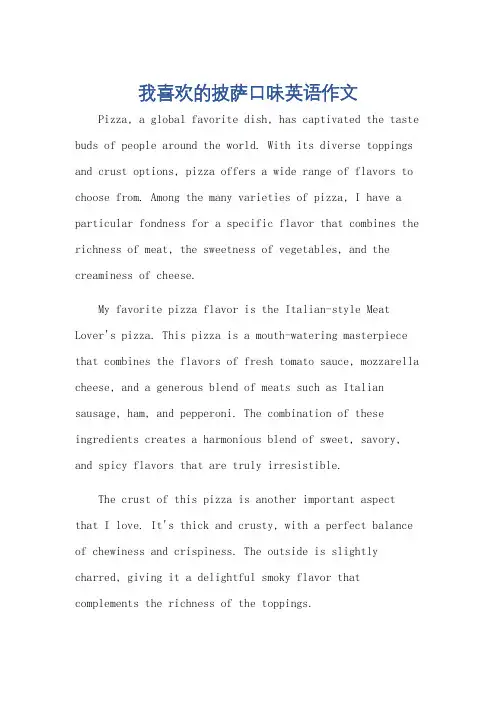
我喜欢的披萨口味英语作文Pizza, a global favorite dish, has captivated the taste buds of people around the world. With its diverse toppings and crust options, pizza offers a wide range of flavors to choose from. Among the many varieties of pizza, I have a particular fondness for a specific flavor that combines the richness of meat, the sweetness of vegetables, and the creaminess of cheese.My favorite pizza flavor is the Italian-style Meat Lover's pizza. This pizza is a mouth-watering masterpiece that combines the flavors of fresh tomato sauce, mozzarella cheese, and a generous blend of meats such as Italian sausage, ham, and pepperoni. The combination of these ingredients creates a harmonious blend of sweet, savory, and spicy flavors that are truly irresistible.The crust of this pizza is another important aspectthat I love. It's thick and crusty, with a perfect balance of chewiness and crispiness. The outside is slightly charred, giving it a delightful smoky flavor that complements the richness of the toppings.The fresh tomato sauce acts as a perfect base for all the toppings, providing a slight tanginess that cuts through the richness of the meat and cheese. The mozzarella cheese, being both creamy and stretchy, adds a layer of richness and texture to the pizza. The meats, being succulent and flavorful, provide a satisfying meaty experience that is truly addictive.What makes this pizza even more special is the addition of bell peppers and onions. These vegetables add a sweet and refreshing note to the pizza, balancing out the richness of the meat and cheese. The bell peppers, being both sweet and crisp, provide a refreshing contrast to the rich flavors of the meat and cheese. The onions, being both sweet and pungent, add depth and complexity to the flavor profile of the pizza.Eating this pizza is an experience that I cherish. From the first bite, the rich flavors explode in my mouth,filling me with pure joy. The chewy crust, the creamy cheese, the succulent meats, and the sweet vegetables all come together to create a flavorful symphony that I can't seem to get enough of.In conclusion, my favorite pizza flavor is the Italian-style Meat Lover's pizza. It's a perfect blend of rich, savory, and sweet flavors that captivate my taste budsevery time I have a slice. The thick and crusty crust, the fresh tomato sauce, the creamy mozzarella cheese, the succulent meats, and the sweet vegetables all come together to create a pizza that I can't resist. Whether it's a lazy weekend afternoon or a busy weekday night, this pizza is always my go-to choice for a satisfying and delicious meal. **我最喜欢的披萨口味**披萨,这一全球喜爱的美食,以其多样的配料和饼底选择,征服了世界各地人们的味蕾。
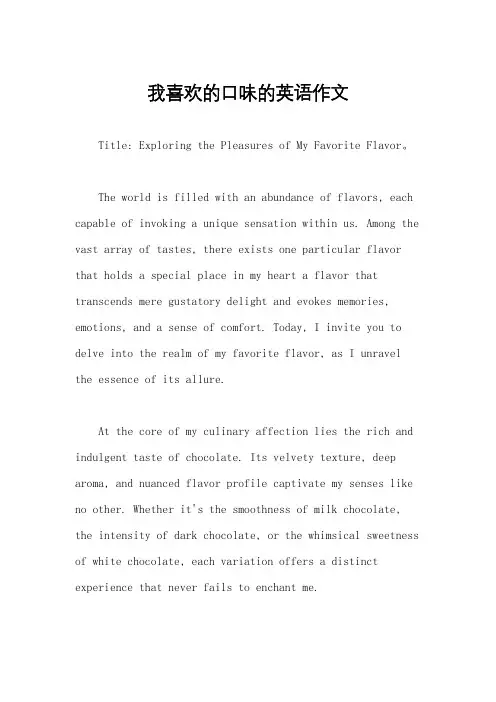
我喜欢的口味的英语作文Title: Exploring the Pleasures of My Favorite Flavor。
The world is filled with an abundance of flavors, each capable of invoking a unique sensation within us. Among the vast array of tastes, there exists one particular flavor that holds a special place in my heart a flavor that transcends mere gustatory delight and evokes memories, emotions, and a sense of comfort. Today, I invite you to delve into the realm of my favorite flavor, as I unravel the essence of its allure.At the core of my culinary affection lies the rich and indulgent taste of chocolate. Its velvety texture, deep aroma, and nuanced flavor profile captivate my senses like no other. Whether it's the smoothness of milk chocolate, the intensity of dark chocolate, or the whimsical sweetness of white chocolate, each variation offers a distinct experience that never fails to enchant me.The allure of chocolate extends beyond its taste alone. It possesses a certain mystique that transcends cultural boundaries and speaks to the soul. From ancientcivilizations who revered cacao as a divine gift to modern-day connoisseurs who celebrate its versatility, chocolate holds a timeless appeal that resonates through the ages.One aspect of chocolate that fascinates me is itsability to transform ordinary moments into extraordinary ones. A simple bar of chocolate can turn a mundane afternoon into a moment of blissful indulgence. Whether enjoyed alone as a solitary treat or shared with loved ones during moments of celebration, chocolate has the power to elevate any experience.Moreover, chocolate serves as a canvas for culinary creativity. It seamlessly integrates into a myriad of desserts, from decadent cakes and creamy mousses todelicate truffles and silky ganaches. Its versatility allows chefs and home cooks alike to experiment with flavors, textures, and presentations, resulting in endless possibilities for gastronomic delight.Beyond its culinary applications, chocolate holds a special place in cultural traditions and rituals around the world. From the exchange of chocolate gifts during holidays to the symbolic significance of chocolate in ceremonies and celebrations, its presence enriches our lives in ways that extend beyond the realm of food.On a personal level, my fondness for chocolate is deeply intertwined with cherished memories and experiences.I recall the joy of baking chocolate chip cookies with my grandmother, the thrill of discovering a hidden stash of chocolate bars as a child, and the warmth of savoring a cup of hot chocolate on a cold winter's day. These moments serve as reminders of the enduring pleasure that chocolate brings into my life.In conclusion, my favorite flavor, chocolate, embodies more than just a taste sensation. It represents a symphony of sensations, emotions, and memories that enrich my lifein countless ways. Its allure transcends mere indulgence, offering a glimpse into the magic of culinary delight andthe profound connections it fosters. As I continue to explore the world of flavors, chocolate will always hold a special place in my heart, a timeless indulgence that never fails to delight the senses and nourish the soul.。
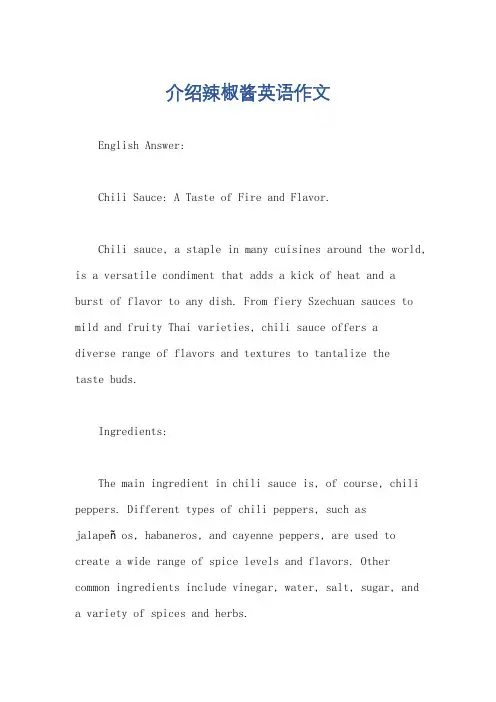
介绍辣椒酱英语作文English Answer:Chili Sauce: A Taste of Fire and Flavor.Chili sauce, a staple in many cuisines around the world, is a versatile condiment that adds a kick of heat and aburst of flavor to any dish. From fiery Szechuan sauces to mild and fruity Thai varieties, chili sauce offers adiverse range of flavors and textures to tantalize thetaste buds.Ingredients:The main ingredient in chili sauce is, of course, chili peppers. Different types of chili peppers, such asjalapeños, habaneros, and cayenne peppers, are used to create a wide range of spice levels and flavors. Other common ingredients include vinegar, water, salt, sugar, and a variety of spices and herbs.Process:The process of making chili sauce varies slightly depending on the desired consistency and flavor profile. Generally, the chili peppers are chopped or pureed and then combined with the other ingredients. The mixture is then heated and simmered until it reaches the desired consistency. Some chili sauces are smooth and creamy, while others have a chunky texture with visible pieces of chili peppers.Culinary Uses:Chili sauce is an incredibly versatile ingredient that can be used to enhance a wide range of dishes. It can be served as a condiment for tacos, sandwiches, burgers, and fried dishes. It can also be used as a marinade for meats and vegetables or as a dipping sauce for appetizers. Additionally, chili sauce can be used as a base for soups, stews, and other sauces.Health Benefits:In addition to its culinary versatility, chili sauce also offers several health benefits. Chili peppers contain capsaicin, a compound that has been shown to have anti-inflammatory and antioxidant properties. Capsaicin may also aid in weight loss and boost metabolism.Popular Varieties:There are countless varieties of chili sauce available, each with its own unique flavor profile. Some of the most popular varieties include:Sriracha: A Thai chili sauce made with red jalapeños and garlic.Tabasco: A Louisiana-style chili sauce made with cayenne peppers and vinegar.Gochujang: A Korean chili paste made with fermented soybeans and chili peppers.Sambal: An Indonesian chili sauce made with a variety of chili peppers, shrimp paste, and other spices.Harissa: A Tunisian chili paste made with roasted red peppers, cumin, and coriander.Conclusion:Chili sauce is a culinary treasure that adds a burst of heat and flavor to any dish. Its versatility and health benefits make it a must-have ingredient for any home kitchen. From fiery Szechuan sauces to mild and fruity Thai varieties, there is a chili sauce for every taste and occasion.中文回答:辣椒酱,火热与风味的碰撞。
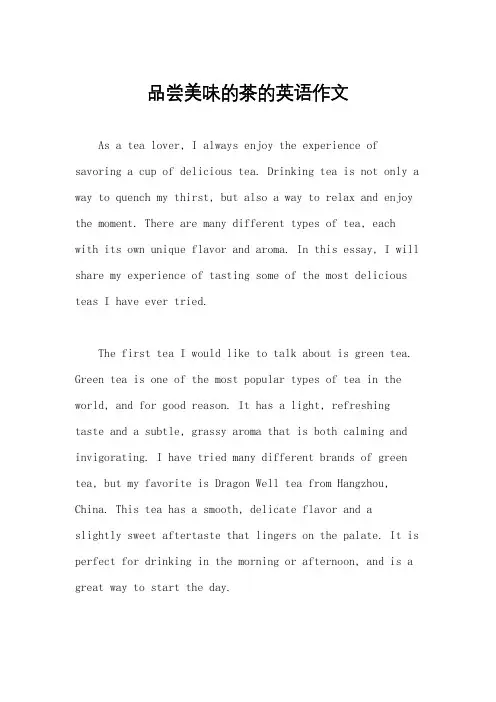
品尝美味的茶的英语作文As a tea lover, I always enjoy the experience of savoring a cup of delicious tea. Drinking tea is not only a way to quench my thirst, but also a way to relax and enjoy the moment. There are many different types of tea, each with its own unique flavor and aroma. In this essay, I will share my experience of tasting some of the most delicious teas I have ever tried.The first tea I would like to talk about is green tea. Green tea is one of the most popular types of tea in the world, and for good reason. It has a light, refreshing taste and a subtle, grassy aroma that is both calming and invigorating. I have tried many different brands of green tea, but my favorite is Dragon Well tea from Hangzhou, China. This tea has a smooth, delicate flavor and aslightly sweet aftertaste that lingers on the palate. It is perfect for drinking in the morning or afternoon, and is a great way to start the day.Another tea that I love is oolong tea. Oolong tea is a semi-fermented tea that has a rich, complex flavor and a floral aroma. It is a great tea to drink in the afternoonor evening, as it has a calming effect on the body and mind. One of the best oolong teas I have ever tried is Tie Guan Yin tea from Anxi, China. This tea has a smooth, velvety texture and a sweet, fruity flavor that is both refreshing and satisfying. It is a great tea to drink after a meal, as it aids in digestion and helps to soothe the stomach.One of the most unique teas I have ever tried is Pu-erh tea. Pu-erh tea is a fermented tea that has a rich, earthy flavor and a deep, mellow aroma. It is a great tea to drink in the evening, as it has a relaxing effect on the body and mind. The best Pu-erh tea I have ever tried is from Yunnan, China. This tea has a smooth, velvety texture and a complex, layered flavor that is both satisfying and intriguing. Itis a great tea to drink on its own, or with a light snack.In conclusion, tasting delicious tea is a wonderful experience that can be enjoyed by anyone. Whether youprefer green tea, oolong tea, or Pu-erh tea, there is a teaout there that is perfect for you. So why not take some time to explore the world of tea, and discover the many flavors and aromas that it has to offer? You may just find your new favorite tea!。
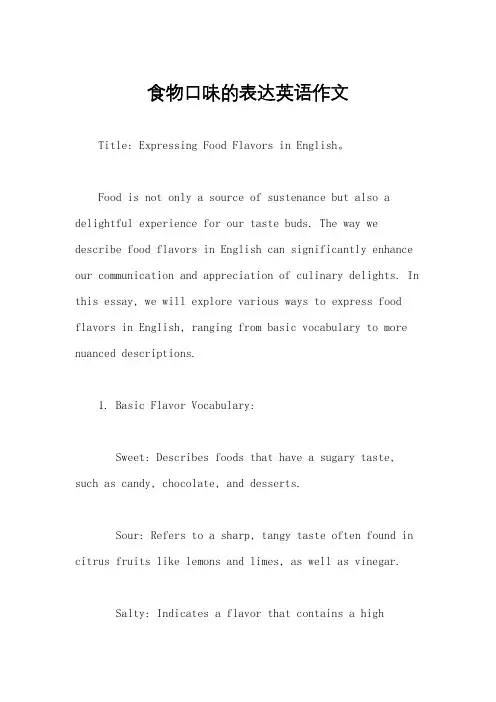
食物口味的表达英语作文Title: Expressing Food Flavors in English。
Food is not only a source of sustenance but also a delightful experience for our taste buds. The way we describe food flavors in English can significantly enhance our communication and appreciation of culinary delights. In this essay, we will explore various ways to express food flavors in English, ranging from basic vocabulary to more nuanced descriptions.1. Basic Flavor Vocabulary:Sweet: Describes foods that have a sugary taste, such as candy, chocolate, and desserts.Sour: Refers to a sharp, tangy taste often found in citrus fruits like lemons and limes, as well as vinegar.Salty: Indicates a flavor that contains a highamount of salt, like potato chips, pretzels, and cured meats.Bitter: Characterizes foods with a sharp, sometimes unpleasant taste, such as dark chocolate, coffee, and certain leafy greens like kale.Spicy: Relates to foods that cause a burning sensation in the mouth due to the presence of spices like chili peppers, black pepper, and curry.2. Descriptive Adjectives for Flavor Intensity:Mild: Used to describe foods with a subtle or gentle flavor, lacking strong or intense taste.Bold: Refers to foods with a strong, pronounced flavor that is assertive and impactful on the palate.Rich: Indicates foods that are full-bodied and flavorful, often associated with ingredients like butter, cream, and cheese.Tangy: Describes foods with a sharp, zesty flavor, usually derived from acidic ingredients like vinegar or citrus fruits.Savory: Characterizes foods that are hearty, satisfying, and rich in umami flavor, such as roasted meats and mushrooms.3. Texture and Mouthfeel:Crispy: Refers to foods that are firm and make a crunching sound when bitten into, like potato chips and fried chicken.Creamy: Describes foods that are smooth and soft, often with a velvety texture, such as mashed potatoes and ice cream.Chewy: Indicates foods that require prolonged chewing, with a resilient and elastic texture, like caramel and beef jerky.Flaky: Characterizes foods with thin layers that separate easily, resulting in a light and airy texture, such as croissants and pie crusts.Juicy: Refers to foods that contain a high amount of liquid, providing a succulent and moist mouthfeel, likeripe fruits and grilled meats.4. Cultural and Regional Flavor Profiles:Umami: A savory taste that is characteristic of foods rich in glutamate, such as soy sauce, tomatoes, and aged cheeses.Bland: Describes foods that lack strong flavor or seasoning, often associated with traditional dishes from regions where spicy or bold flavors are not common.Zesty: Indicates foods that are lively and refreshing, often enhanced with citrusy or aromatic ingredients, like lemon zest and fresh herbs.Fiery: Refers to foods that are intensely spicy or hot, typically associated with cuisines known for their use of chili peppers and other pungent spices.5. Figurative Language and Metaphors:Bursting with flavor: Describes foods that are exceptionally tasty and flavorful, creating a sensation of explosion on the palate.Melt-in-your-mouth: Indicates foods that are so tender and delicious that they seem to dissolveeffortlessly upon tasting.Lip-smacking: Refers to foods that are so delicious that they make you smack your lips in satisfaction.Taste the rainbow: A playful phrase often used to describe a variety of colorful and flavorful foods, such as fresh fruits and vegetables.In conclusion, the English language offers a rich array of vocabulary and expressions to describe food flavors, allowing us to communicate our culinary experiences with precision and creativity. Whether it's the sweetness of a ripe mango or the spiciness of a bowl of chili, mastering the art of flavor expression enhances our appreciation for the diverse and delicious world of food.。
不一样的水果,不一样的口味英语作文English Answer:Fruits come in various shapes, sizes, colors, and flavors. They offer a wide range of nutrients, such as vitamins, minerals, fiber, and antioxidants, which are essential for maintaining good health. Different fruits have distinct flavors that can be described in a myriad of ways.Some fruits, like bananas, have a sweet and creamy flavor. Bananas are rich in potassium, which is an important mineral for regulating blood pressure and heart function. Other fruits, such as strawberries, have a tangy and slightly sweet flavor. Strawberries are a good source of vitamin C, an antioxidant that helps protect cells from damage.Citrus fruits, like oranges and grapefruit, have a tart and refreshing flavor. They are packed with vitamin C,which is essential for immune function and collagen production. Apples, on the other hand, have a crisp and slightly tart flavor. Apples are a good source of fiber, which helps regulate digestion and keeps you feeling full.Tropical fruits, like mangoes and pineapples, have a sweet and juicy flavor. Mangoes are rich in beta-carotene, an antioxidant that helps protect against heart disease and certain types of cancer. Pineapples contain bromelain, an enzyme that has anti-inflammatory properties.Berries, like raspberries and blueberries, have a sweet and slightly tart flavor. They are rich in antioxidants, which help protect against oxidative stress. Pomegranates, with their vibrant red seeds, have a sweet and tangy flavor. Pomegranates are a good source of ellagic acid, an antioxidant that has been linked to reduced inflammation.Cherries, with their deep red color, have a sweet and slightly tart flavor. They are rich in anthocyanins, antioxidants that have been associated with improved heart health and reduced risk of certain chronic diseases. Grapes,both red and green, have a sweet and slightly tart flavor. Grapes are a good source of resveratrol, an antioxidantthat has been linked to longevity and reduced risk of cardiovascular disease.The flavors of fruits can be enhanced by pairing them with other ingredients. For example, fruits can be combined with yogurt, granola, or honey to create a delicious and nutritious breakfast. Fruits can also be added to salads, smoothies, or desserts to add sweetness and flavor.Overall, the diverse flavors of fruits offer a wide range of culinary and health benefits. They can be enjoyed fresh, cooked, or juiced, and can be incorporated into a variety of dishes to create delicious and nutritious meals.中文回答:水果的形状、大小、颜色和口味各不相同。
介绍月饼的口味英语作文In the realm of delectable Chinese pastries, mooncakes stand out as an emblematic delicacy, especially during the festive season of the Mid-Autumn Festival. Renowned for their diverse flavors, mooncakes offer a tantalizing array of tastes that cater to a wide range of palates. Let's embark on a flavorful journey to explore the various mouthwatering flavors of mooncakes.Traditional mooncakes, often characterized by their rich, dense fillings, come in several classic flavors that have delighted generations. One such flavor is lotus seed paste, renowned for its smooth texture and subtly sweet taste. Lotus seed paste mooncakes frequently feature whole salted egg yolks nestled within, adding a savory contrast to the sweetness of the paste.Another beloved traditional flavor is red bean paste, known for its slightly grainy texture and comforting sweetness. Red bean paste mooncakes offer a delightfulblend of sweetness and earthiness that appeals to those with a penchant for traditional flavors.For those seeking a more contemporary twist, there is a plethora of innovative flavors that push the boundaries of mooncake craftsmanship. One such flavor is green tea, where the fragrant notes of matcha meld seamlessly with the richness of the mooncake pastry, creating a harmonious balance of flavors.Similarly, durian mooncakes cater to adventurous palates with their distinctive aroma and creamy texture. Despite its polarizing reputation, durian aficionados revel in the opportunity to indulge in this exotic flavor encased within a delicate mooncake shell.In recent years, bakeries have also introduced exotic fruit flavors such as mango and pineapple, infusing mooncakes with tropical sweetness that transports the taste buds to sun-kissed paradises. These fruit-filled mooncakes offer a refreshing departure from tradition while maintaining the essence of the festival's spirit.For those with a penchant for indulgence, luxury ingredients such as truffles, nuts, and even champagne have found their way into premium mooncake offerings. These opulent creations elevate the humble mooncake to a gourmet experience, appealing to discerning palates with their decadent flavors and exquisite craftsmanship.Furthermore, health-conscious consumers can now enjoy guilt-free indulgence with low-sugar or even sugar-free mooncakes, which prioritize wholesome ingredients andnatural sweetness substitutes without compromising on taste.In conclusion, the world of mooncake flavors is as diverse as it is delightful, offering something foreveryone to savor and celebrate during the Mid-Autumn Festival. From timeless classics to innovative creations, each bite of a mooncake tells a story of tradition, innovation, and the timeless joy of shared festivities.。
当地人的口味英语作文Local Taste。
When it comes to food, every region has its own unique flavors and dishes that reflect the local culture and traditions. As a food enthusiast, I have always been fascinated by the diverse and delicious cuisine that can be found in different parts of the world. However, I believe that the best way to truly experience a region's culinary delights is to sample the food that is enjoyed by the local people. In this essay, I will explore the concept of "local taste" and discuss why it is important to embrace and appreciate the food that is loved by the residents of a particular area.One of the most enjoyable aspects of traveling to a new place is the opportunity to try the local cuisine. Whether it's a steaming bowl of pho in Vietnam, a hearty plate of paella in Spain, or a spicy curry in India, there is something special about eating the food that is beloved bythe people who live in that region. Local dishes are often made with fresh, seasonal ingredients that are sourced from nearby farms and markets, giving them a unique and authentic flavor that cannot be replicated elsewhere. By sampling the food that is enjoyed by the locals, travelers can gain a deeper understanding of the culture and traditions of the area they are visiting.In addition to the flavors and ingredients, the act of eating local food can also provide insight into the customs and way of life of a particular region. For example, in many Mediterranean countries, it is common for people to enjoy a leisurely meal with family and friends, often taking several hours to savor each course and engage in lively conversation. In contrast, street food stalls in bustling Asian cities offer a more fast-paced dining experience, where people gather to enjoy quick andflavorful dishes on the go. By observing and participating in these dining customs, travelers can gain a greater appreciation for the local way of life and develop a deeper connection to the places they visit.Furthermore, embracing local taste can also have a positive impact on the environment and the community. By supporting small, independent restaurants and food producers, travelers can help to sustain local economies and preserve traditional food cultures. Additionally, eating local food often means consuming dishes that are made with minimal processing and packaging, which can contribute to a reduction in food waste and environmental impact. By choosing to eat the food that is loved by the local people, travelers can make a positive contribution to the places they visit and help to ensure that theseculinary traditions continue to thrive for future generations.In conclusion, the concept of "local taste" is an important and enriching aspect of travel. By embracing and appreciating the food that is enjoyed by the residents of a particular region, travelers can gain a deeper understanding of the culture, traditions, and way of life of the places they visit. Furthermore, supporting local food producers and dining establishments can have apositive impact on the environment and the community.Therefore, I encourage all travelers to seek out and savor the local cuisine wherever they go, as it is truly the best way to experience the unique flavors and traditions of a region.。
介绍葡萄口味英语作文Grapes are one of the most popular fruits in the world, and for good reason. They are delicious, juicy, and come in a variety of flavors. In this article, we will explore the different grape flavors and what makes them unique.Firstly, let's talk about the most common grape flavor: sweet. Sweet grapes are the ones that most people are used to eating. They are juicy and have a high sugar content, which makes them perfect for snacking on. Sweet grapes come in a range of colors, including green, red, and purple. Green grapes are usually the sweetest, while red and purple grapes have a slightly more tart flavor.Next, we have sour grapes. These grapes are less common than sweet grapes, but they are still a popular choice for some people. Sour grapes have a lower sugar content and a higher acidity, which gives them their sour flavor. They are often used in cooking, especially in dishes that require a bit of tanginess.Another grape flavor that is gaining popularity is musky. Musky grapes have a unique flavor that is hard to describe. They are often described as having a musky or earthy taste, with hints of spice and floral notes. Musky grapes are usually smaller than sweet grapes and have a thicker skin.Finally, we have the wine grape. Wine grapes are not meant to be eaten raw, but they are an important grape flavor nonetheless. Wine grapes are used to make wine, and each variety of grape produces a different type of wine. Some wine grapes are sweet, while others are sour or musky. The flavor of the wine depends on the grape variety, as well as the fermentation process.In conclusion, grapes are a versatile fruit that comein many different flavors. Whether you prefer sweet, sour, musky, or wine grapes, there is a grape out there for everyone. So next time you're at the grocery store, why not try a new variety of grape and discover a new flavor sensation?。
我喜欢的中国美食小学英语作文I like Chinese food because it is delicious and diverse. There are so many different types of Chinese cuisine, from spicy Sichuan dishes to delicate Cantonese dim sum. One of my favorite Chinese dishes is Kung Pao Chicken. It is a spicy, stir-fried dish made with chicken, peanuts, vegetables, and chili peppers. The combination of flavors and textures in Kung Pao Chicken is simply irresistible.Another Chinese dish that I love is Sichuan hot pot. It is a communal meal where everyone gathers around a simmering pot of broth and cooks their own meat, seafood, and vegetables. The broth is flavored with Sichuan peppercorns and chili peppers, giving it a numbing and spicy flavor. I enjoy the interactive nature of hot pot meals, as well as the bold and intense flavors.In addition to these savory dishes, I also have a sweet tooth for Chinese desserts. One of my favorites is egg tarts, which are small pastries filled with a creamy egg custard. They are not overly sweet and have a delicate, flaky crust. I also enjoy tangyuan, which are glutinous rice balls filled with sweet black sesame paste or red bean paste. They are often served in a warm, sweet soup and are a comforting treat.Overall, Chinese cuisine offers a wide range of flavors and textures, from spicy and bold to delicate and sweet. I appreciate the diversity and complexity of Chinese food, and it is always a joy to explore new dishes and flavors.我喜欢中国美食,因为它美味多样。